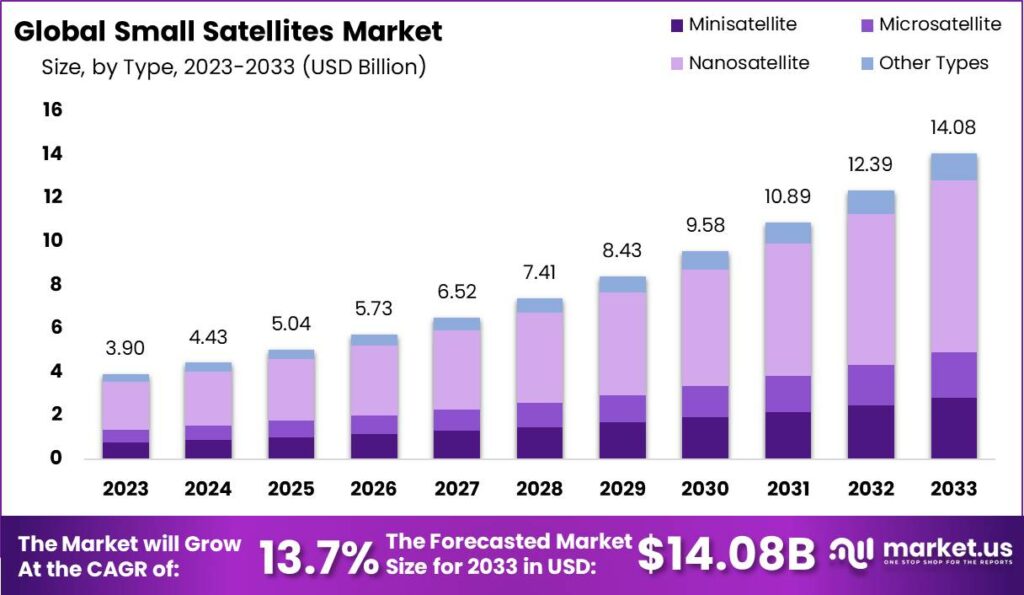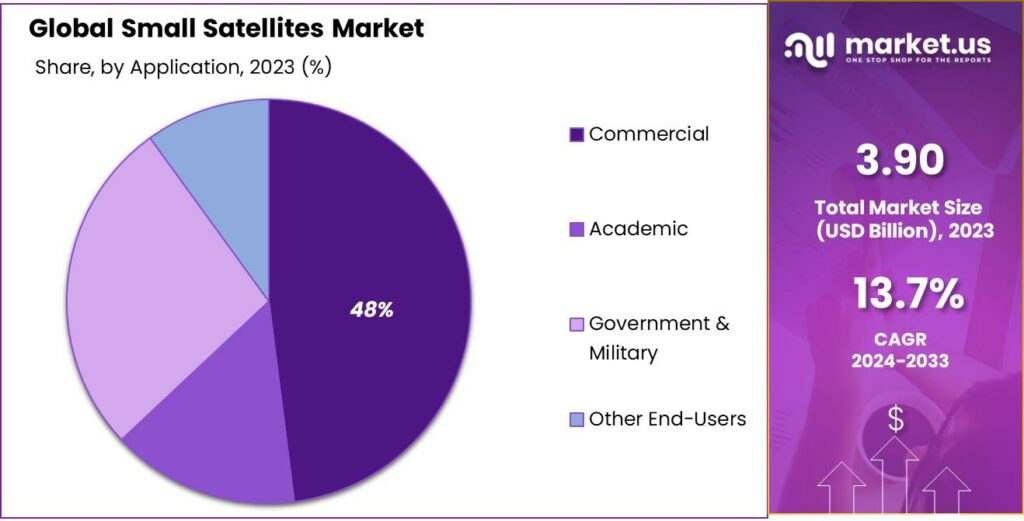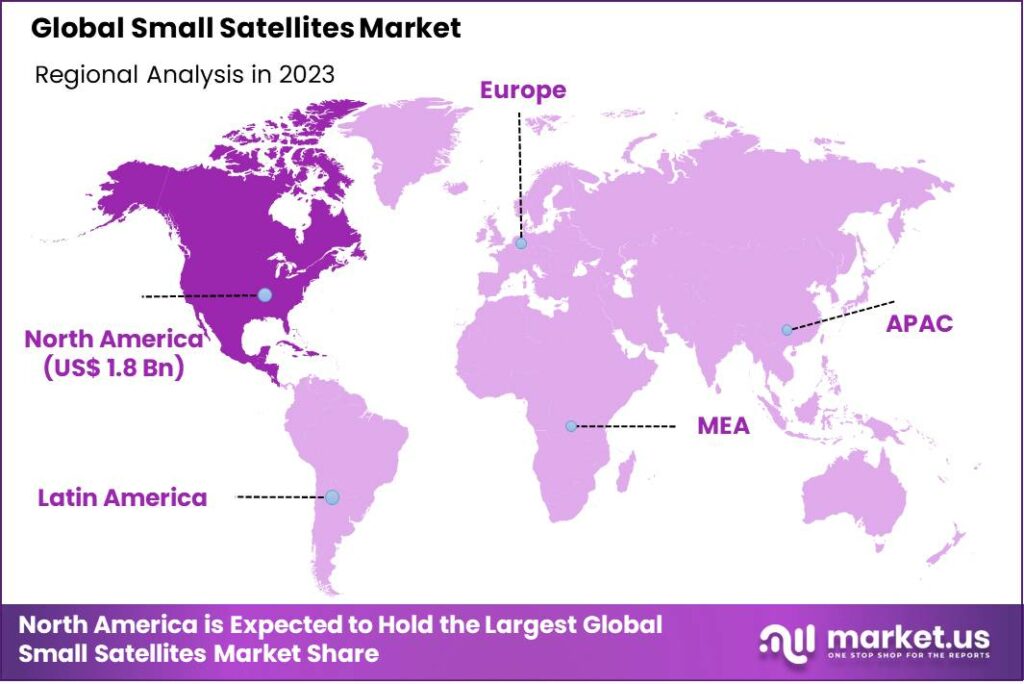Table of Contents
Based on data from Market.us, the global small satellites market is projected to reach an impressive value of approximately USD 14.08 billion by 2033, up from USD 4.43 billion in 2024. This represents a robust compound annual growth rate (CAGR) of 13.7% during the forecast period spanning from 2024 to 2033. This significant growth can be attributed to the increasing demand for small satellites in various sectors including telecommunications, earth observation, and scientific research.
Small satellites, commonly referred to as SmallSats, encompass a broad range of satellite types distinguished primarily by their size and mass. These include microsatellites, nanosatellites, and CubeSats, each falling into specific weight categories – microsatellites weigh between 10 to 100 kilograms, nanosatellites 1 to 10 kilograms, and CubeSats often come in standardized units of 10x10x10 cm. Originally developed for academic and scientific missions, small satellites are now widely utilized across various sectors due to their cost-effectiveness and modular design, which allows for rapid assembly and deployment.
The market for small satellites has witnessed significant growth, driven by their lower cost, shorter development cycles, and the increasing range of applications from Earth observation to global internet coverage. The proliferation of satellite constellations, particularly for telecommunications and real-time data services, has further propelled this market. Companies and governments are investing in small satellites to enhance connectivity, monitor environmental changes, and expand scientific research. The ease of deploying these satellites compared to traditional large satellites also lowers barriers for new entrants, making space more accessible to smaller companies and startups.

Market Growth Analysis
- The small satellites market is expected to witness strong growth, with a projected compound annual growth rate (CAGR) of 13.7% from 2024 to 2033. By 2033, the market size is estimated to reach USD 14.08 billion, driven by increasing demand for cost-effective and flexible satellite solutions.
- In 2023, the Nanosatellite segment dominated, securing an impressive 56% market share. The rising use of nanosatellites for communication, navigation, and research is a key driver behind this growth.
- The Earth Observation & Remote Sensing segment led the market with a 45% market share in 2023. Governments and private companies are increasingly relying on small satellites for climate monitoring, disaster management, and agricultural assessments.
- The Commercial segment emerged as the strongest player in 2023, accounting for 48% of the market. The growing interest from private space companies, advancements in satellite technology, and cost reductions have fueled this expansion.
Analysts’ Viewpoint
Investment opportunities in this sector are substantial, given the escalating demand for small satellites in governmental and commercial sectors. Governments worldwide are leveraging these satellites for defense, surveillance, and environmental monitoring, necessitating continual innovation and expansion in this arena.
Meanwhile, the commercial sector is exploring new frontiers in global internet coverage and real-time data services, presenting lucrative prospects for investment. However, potential investors should be mindful of risks associated with rapid technological changes and the regulatory environment that governs space activities.
On the regulatory front, the environment remains stringent yet adaptive, aiming to keep pace with the rapid advancements and increased frequency of satellite launches. Companies are urged to navigate these regulations carefully, aligning their operational and developmental strategies with compliance to ensure sustained growth and market penetration. Moreover, the integration of AI and machine learning in satellite operations is a trend gaining momentum, promising to enhance data processing capabilities and operational efficiency, thus further propelling the market forward.
Take advantage of our unbeatable offer - buy now!

Report Segmentation
Type Analysis
Dominance of Nanosatellites
In 2023, the landscape of the Small Satellites Market was significantly shaped by the nanosatellite segment, which achieved a dominant position with a substantial market share exceeding 56%. This prominence can be attributed to the escalating demand for cost-effective satellite solutions coupled with advancements in miniaturization technologies.
These factors have facilitated broader accessibility and utility across various sectors, bolstering the adoption rate of nanosatellites. Their applications range from communication and earth observation to advanced research in space technology, which underscores their pivotal role in the ongoing evolution of small satellite capabilities. The sustained investment and innovation within this segment underscore a robust growth trajectory anticipated to continue expanding in the forthcoming years.
Application Insights
Earth Observation & Remote Sensing
The Earth Observation & Remote Sensing segment reinforced its leading status in the Small Satellites Market in 2023, commanding over 45% of the market share. The growth of this segment is driven by the escalating global emphasis on climate monitoring, disaster management, and national security measures, all of which rely heavily on the accurate and timely data provided by earth observation satellites.
Furthermore, the integration of AI and big data analytics with remote sensing technology has enhanced the precision and usability of the data, propelling this segment’s expansion. The strategic deployment of small satellites for earth observation purposes not only supports environmental and agricultural planning but also plays a crucial role in urban development and border surveillance, ensuring its continued relevance and expansion.

End-User Analysis
Commercial Sector’s Leadership
In 2023, the Commercial sector emerged as the predominant end-user in the Small Satellites Market, securing over 48% of the total market share. This sector’s dominance is underpinned by the increasing deployment of small satellites for a variety of commercial applications including telecommunications, internet services, and commercial imagery.
As businesses continually seek competitive advantages through technological advancements, small satellites offer a viable solution by providing critical data and connectivity at a fraction of the cost of traditional large-scale satellites. This cost-effectiveness, combined with rapid technological advancements, has made small satellites a cornerstone of modern commercial space endeavors, with expectations for continued growth and innovation driving the market forward.
Regional Insights
In 2023, North America maintained a strong lead in the Small Satellites Market, holding a commanding market share of over 47%. This can be attributed to the region’s robust technological infrastructure and the presence of leading aerospace and satellite companies, which are pivotal in driving innovation in the satellite industry.
The supportive governmental policies and significant investment in research and development activities have also played essential roles in fostering the growth of the small satellite market in this region. Moreover, the strategic collaborations between government agencies and private sector entities are expected to propel the development of advanced satellite technologies, thereby sustaining North America’s influential position in the global market landscape.

Key Market Segments
Type
- Minisatellite
- Microsatellite
- Nanosatellite
- Other Types
Application
- Earth Observation & Remote Sensing
- Satellite Communication
- Science & Exploration
- Mapping & Navigation
- Space Observation
- Other Applications
End-User
- Commercial
- Academic
- Government & Military
- Other End-Users
Top Key Players
- Airbus S.A.S.
- GomSpace
- L3Harris Technologies Inc.
- Lockheed Martin Corporation
- Northrop Grumman Corporation
- Planet Labs Inc.
- Sierra Nevada Corporation
- Thales Group
- Aerospace Corporation
- The Boeing Company
- Other Key Players
Conclusion
The small satellite sector stands at the forefront of a transformative era in space technology. Characterized by rapid advancements and expanding market opportunities, small satellites are reshaping our approach to space exploration, telecommunications, and Earth observation.
The ongoing miniaturization of components and integration of cutting-edge technologies such as AI and machine learning are not only enhancing the capabilities of these compact satellites but also driving down costs, making space more accessible to a broader array of players – from emerging startups to established space agencies and commercial entities.
Discuss your needs with our analyst
Please share your requirements with more details so our analyst can check if they can solve your problem(s)



